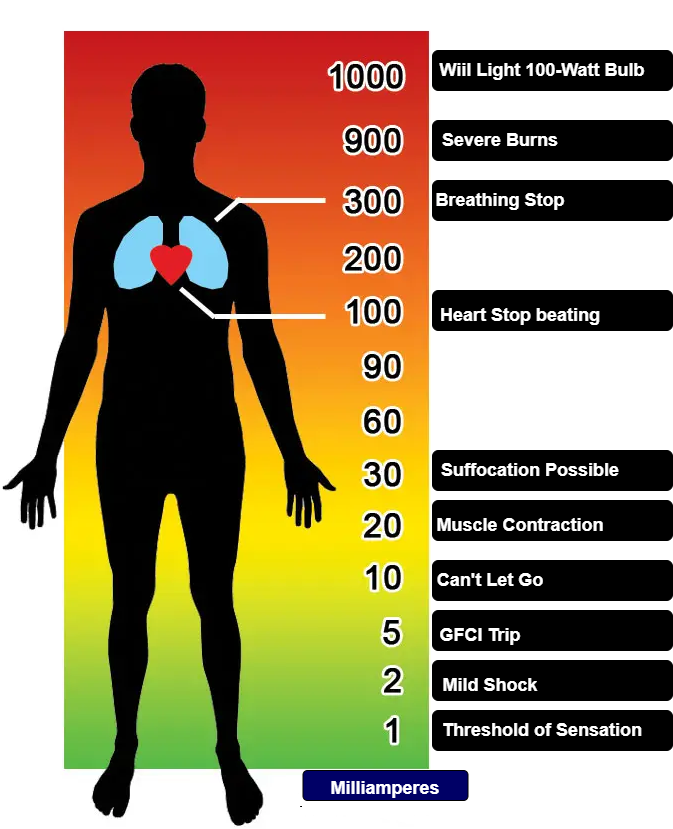Effects of electric current on the human body are burns, irregular heartbeat, tingling sensation, loss of consciousness, and headache.
In today’s world of advancement and technology, electricity is one of the most significant and indispensable elements of our everyday life. Today, electricity has become a necessity in almost every field of life, like households, businesses, transportation, and more.
Electricity or electric current has several advantages, such as being clean, efficient, cost-effective, easy to produce and use, and more. But it also has various hazards associated with it.
If electricity is not handled properly, it can cause severe harm to the human body. Therefore, it is very important to know how to handle electricity with care and what effects it can have on the human body.
In this article, we will discuss all the major effects of electric current on the human body. So, let’s get started with the basic definition of electric current.
What is an Electric Current?
Electric current is a quantity that is defined as a directed flow of electric charge or electrons through a conducting medium. Ampere (A) is the SI unit of electric current. The electric current is represented by the letter I or i.
Electric current can be of two types depending on the nature of the movement of charge through the conductor. The direct current (DC) and alternating current (AC) are two types of electric current.
Direct current is a unidirectional electric current that always flows in the same direction. On the other hand, alternating current is bidirectional, as it flows in both directions alternatively.
How do We get an Electric Shock?
It is well-known that the human body is a conductor of electricity or electric current. Hence, electric charge can pass through the human body.
When we touch an electric live wire or any other electrically charged material, there is a condition that can create a potential difference; for example, we are standing on the earth or holding another wire of different potential.
Due to this potential difference, an electric current starts flowing from higher potential to lower through our body since the human body draws a heavy current, which causes a sensation of electric shock.
Electric current can burn or damage the tissues of our body on the path through which it flows.
How Much Current Cause Electric Shock to the Human Body?
Experimentally, it has been seen that an electric current below 5 mA is not considered dangerous to the human body. However, the electric current in the range of 10 mA to 20 mA can be hazardous, as the human body starts losing muscular control at this current level.
Now, we will discuss the effects of electric current on the human body.
Effects of Electric Current on the Human Body
The major effects of electric current on the human body are given in the following table:
| S. No. | Intensity of Current | At this level, a person gets a painful electric shock and can lose muscular control. This range of current is called “freezing current” or “let-go current”. |
| 1. | 0 – 1 mA | The person will feel a sensation of a mild tickle in the body part touching the electric wire. |
| 2. | 1 – 5 mA | For this current level, the person feels the sensation akin to pins and needles in the body part touching the wire. |
| 3. | 5 – 15 mA | This current level starts contracting the muscles. It is called the “Can’t Let Go” range. |
| 4. | 15 – 25 mA | This current level can paralyze the respiratory system. |
| 5. | 25 – 60 mA | This current level causes ventricular fibrillation, heart paralysis, tissue burning, and death probable. |
| 6. | 60 -100 mA | This current level increases the blood pressure. The heart starts malfunctioning. A person can lose consciousness. |
| 7. | 100 mA and higher | This current level causes ventricular fibrillation, heart paralysis, tissue burning, and the possibility of death. |
The effect of electric current in the human body is shown in the image below.

Conclusion
In this article, we have learned all about electric current and its effects on the human body. Different levels of electric current cause different harms to the human body. In conclusion, low current magnitudes, usually less than 1 mA, are not considered dangerous.
However, more than 15 mA heavy current can cause visible harm to the human body. Hence, we should always be careful while working with electricity. Otherwise, it can cause severe damage to our bodies, even death.
Related Articles: